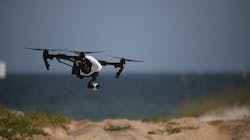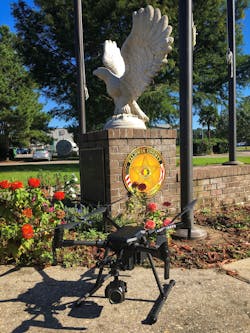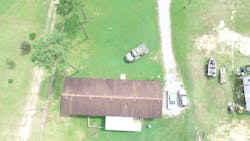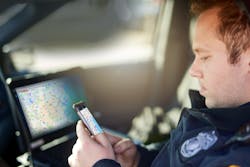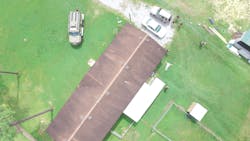Train, Fund, and Lift Off
Over the last ten years, unmanned aerial vehicles—commonly known as drones—have grown leaps and bounds from the hobbyist toys they were first considered. They are now equipped with new technology and can be tailored specifically for law enforcement. While the units have become easier to use and training is now more readily available, launching a drone program can still prove to be a daunting task.
From gaining public acceptance for a program to finding funding to start one up, there a multitude of things law enforcement agencies must keep in mind. Law enforcement officials and industry professionals both agree that while the process has become easier in some ways, agencies still need to perform their due diligence.
Train
Before launching its drone program about six years ago, the Baldwin County Sheriff’s Office would have to call in a helicopter from the Alabama Law Enforcement Agency in order to get “eyes in the sky.” With fuel and maintenance included, the cost to taxpayers averages about $750 an hour every time they would fly out to assist.
“Drones are quick and easy to deploy and we use them for just a multitude of things,” says Lt. Daniel Steelman, who helped facilitate the launch of his agency’s drone program. “It’s just another tool to help us better serve the public and better get our job done.”
The initial start up of a drone program for the BCSO was approximately $2,500. With additional batteries, controllers, cameras and FLIR cameras, the agency has around $30,000 invested in the program now.
“For a few thousand bucks, you can get a really high-tech platform that’s easy to fly, easy to scale.”
— Justin Steinke, Regional VP of Sales, Americas with AiRXOS
The first step of getting officers trained and certified to fly drones is to apply for a COA (Certificate of Authorization) through the Federal Aviation Administration or obtain a part 107 pilot’s license. Public safety entities can fly drones under either. Lt. Daniel Steelman says that his agency’s drone pilots attend 40 hours of advanced training before entering a field training mentor-ship program that allows them to shadow an experienced drone pilot for a period of time before being becoming a fully operable drone pilot.
As of now, the agency has three officers who are certified and three more who are undergoing training. The agency began with one drone unit and now it is up to five units which include a DJI Matrice 200, DJI Inspire, DJI Mavic Pro 2, DJI Mavic Air and DJI Spark. Steelman says that the agency plans to add up to three more units by the end of the year. The Baldwin County Sheriff’s Office has been working with Adorama Business Solutions for more than 10 years to purchase cameras and forensic and evidence supplies. When the company began offering drones, Steelman says his agency began purchasing them after previously considering the technology.
“Because we had that preexisting relationship, they came in and were easy to work with,” he says. “They were knowledgeable in not just selling the product, but knowing things about the product.”
Caroleann Fusco, a Law Enforcement, State & Local Government Specialist with Adorama Business Solutions, says agencies need to establish a Standard Operating Procedure that fits within their current SOP and that then enables them to now make the move towards introducing the program. “At that point, they can then present a good community program that benefits usually more than just one agency or one town or one city,” she says.
Fund
Fusco stresses that agencies need to weigh their options when it comes to paying for a drone program. “First and foremost it starts with the availability of funding. Most of the agencies will do some research to see if there are grants available or funding they might be able to get from other agencies,” she says.
“Most law enforcement agencies don’t have a huge surplus of capital to spend on new technology,” he says. “Making sure the technology is at the right price point is something that has been a challenge for a number of years and is starting to change in a positive way for most of the agencies out there.”
Steinke compared the dropping price of drones over the last decade to that of other technologies such as laptops and phones over the last 20 years. “Typical with most technologies, prices come down and capabilities have gone up. You’ve got more cameras and better cameras on a smaller drone that’s at a cheaper price,” he says. “Nowadays you can have a high definition visual camera and a FLIR camera all in the same platform that’s still very small, efficient and cost-effective…It used to be drones were $50,000 to a $100,000 years ago and you can imagine how impossible it would be for a department to scale when you’ve got a price-point there. Now, for a few thousand bucks, you can get a really high-tech platform that’s easy to fly, easy to scale, and, if for some reason that drone crashes, they can buy a new one because it’s not exorbitantly expensive.”
Public acceptance
When it comes to pitching a drone program to local officials, public acceptance can be key. As law enforcement agencies began adding UAVs (unmanned aerial vehicles) to their fleets, the term “drone” was often used to describe them—a label primarily used for unmanned military aircraft. The public often assumed the units would be armed or would only be used for surveillance.
“The reality is that we’re starting to see a lot of really positive use cases now. Saving missing children, finding people that are trapped in a burning building,” Steinke says. “Drones have a huge impact on the safety of the public. We’re getting over, I think, the hurdle of public acceptance and we’re starting to get more cities and counties accepting that technology as a kind of part of their everyday lives.”
“The biggest thing is to make sure you know how your community feels about what you’re going to do with the drones.”
— Caroleann Fusco, a Law Enforcement, State & Local Government Specialist with Adorama Business Solutions
He stresses that while the public may be more accepting, compliance is key since law enforcement agencies use a lot of tax dollars to support and fund drone programs. “You really have several layers of compliance to deal with. You’ve got federal compliance as it relates to airspace and the ability to use that technology in the air. You’ve got state and local rules and regulations that might pertain to how drones are used,” he says. “The biggest thing is making sure that as that program moves forward, all that compliance is tracked in a way where should anyone have any questions or queries in a particular use case of a department that they’ve got the right data and reporting structures to support what they were doing and making sure they were doing it all in compliance with all the rules and regulations that surround that technology.”
Fusco works with agencies interested in starting drone programs on ways they can present them that will gain public acceptance. “I think they absolutely have to keep in mind how they are going to present that drone program because the community can really make a difference,” she says. “The biggest thing is to make sure you know how your community feels about what you’re going to do with the drones. That’s why in the beginning we talk to a lot of the agencies about how they are going to present it out there. What is the mission? It’s important to have a mission in mind so the people don’t feel like you just want to fly around and look into their windows or in their backyard. They have to keep that in mind and understand how their community is going to respond to it.”
Advancements
Drones first started out as a hobby technology and a lot of the platforms that were built and a lot of the drones that were available were designed mainly for hobbyists. Steinke says that the reality is that law enforcement agencies need a lot of different types of technology to make that program work.
Fusco says that as new technology has taken hold, the ease of use of the units has increased considerably. “Ten years ago it was very difficult to fly a drone, and now with all of the technology with the controller and its flight capability, it is so much easier for agencies to fly these,” says Fusco, adding that as the ease of use continues to improve, more officers are becoming open to the idea of flying drones. “Trying to train yourself how to fly a drone and then getting the department to put together the program—most of these guys are having to do that on their own. In order to sell the program, you have to be able to walk the walk and talk the talk. The easier it is to use, the faster it will get accepted into these types of agencies.”
Fusco says that some of the biggest advancements in drone technology have been made in the mapping and the tracing capabilities. “It gives them many different things that they can now move forward and do, say following up on certain crime areas or following up on where water is. It maps out the areas and helps them set up where their people can cover and where a drone might be a better or faster or more economical way to cover those areas.” The introduction of infrared and zoom cameras have also been a huge plus when it comes to getting drones accepted as an everyday tool by officers.
During a recent incident in which the Baldwin Sheriff’s Office deployed a drone, there was an Alzheimer’s patient who wandered away from his home at night and into the woods. Steelman says that the agency’s bloodhound initially located him, but deputies were able to use a drone equipped with a FLIR camera to direct the man to the nearest roadway. So far, the agency only has one drone equipped with a FLIR camera, which was purchased earlier this year.
“At night, you’re shut down without a FLIR. At night you can’t see anything,” says Steelman. “A lot of times we deal with the critical missing persons cases, where an elderly person is in danger and it could not have such a great ending. Using a drone equipped with a FLIR has helped us locate those people.”
Steelman says that while the price of the units have gone down some. They have also become more advanced and include more features than in the past including FLIR and zoom cameras. “They’ve evolved into just a better tool,” he says. “They are more user friendly. They are more stable and easier to navigate. They stay on station better when you are trying to do something. When you are trying to provide overwatch of something happening you are able to just hover from a distance and see versus constantly trying to control it and fight it, they do a really good job of maintaining stability and being able to see the video stream or still photos.”
“Drones are quick and easy to deploy and we use them for just a multitude of things,” he says. “It’s just another tool to help us better serve the public and better get our job done.”
Creative Uses of Your Drone
Traffic Accident Investigation. Agencies can use a drone above a traffic accident on a major highway to capture images and clear that accident much faster than they used to. Most accidents on a large highway used to take hours to clear using ground-based equipment. Now using a drone, agencies can take the needed photographs within as little as 15 minutes and get the highway opened up much faster.
Search and Rescue. Whenever there's a missing child or a missing person, agencies are able to use drones to quickly survey large area whereas on foot, searches would require lots of people, resources and time to do the same thing.
Disaster Response. If there's a tornado, hurricane or another major disaster, drones can provide a quick and efficient way to understand where damage has occurred, where the people are, who needs help and how to deploy the resources to be able to aid them.
Active Shooter Events. In a scenario where an armed suspect is reported inside a building, agencies will typically send in a K-9 or a SWAT team. Instead of having send a dog or officers into the line of fire, agencies can instead send a drone in to assess to situation.
Social Distancing. In the age of COVID-19, a drone provides a social distancing arm that wasn't there before. A drone provides the ability to keep a distance from a large crowd or a group of people if needed.

Paul Peluso | Editor
Paul Peluso is the Managing Editor of OFFICER Magazine and has been with the Officer Media Group since 2006. He began as an Associate Editor, writing and editing content for Officer.com. Previously, Paul worked as a reporter for several newspapers in the suburbs of Baltimore, MD.
